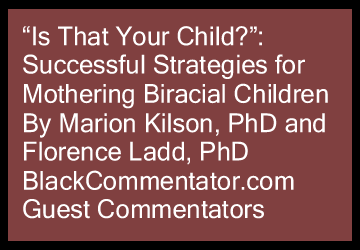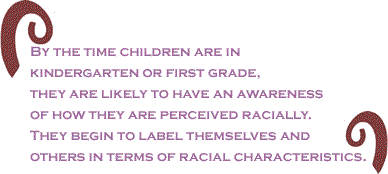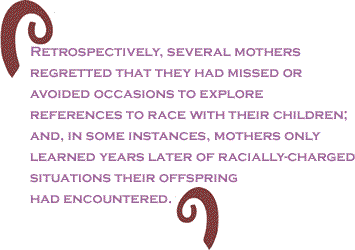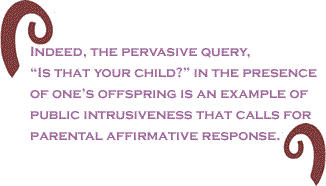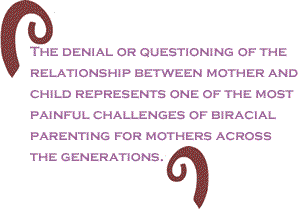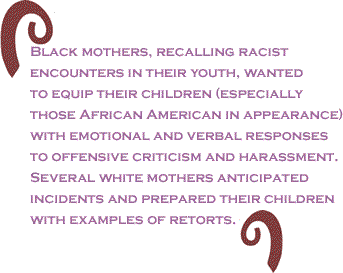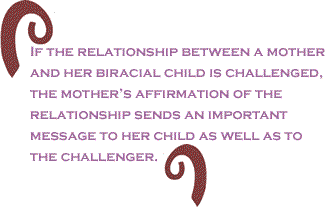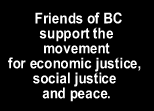
|
||||||||||||||||||||||
 |
||||||||||||||||||||||
 |
||||||||||||||||||||||
 |
||||||||||||||||||||||
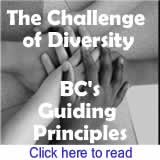 |
||||||||||||||||||||||
 |
||||||||||||||||||||||
 |
| The current issue is always free to everyone |
|
|
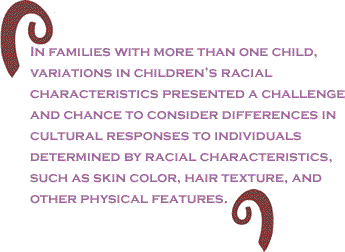 |
“Is that your child?” is a question that countless mothers of biracial children in the United States encounter whether they are African Americans or European Americans, rearing children today or a generation ago, living in cities or suburbs, are upper middle class or middle class. In our forthcoming book we probe mothers’ responses to this query as well as their accounts of other challenges and rewards of parenting biracial children. We began our conversations about parenting biracial children by recounting our own experiences. Florence Ladd, an African American, and Marion Kilson, a European American, became parents of biracial children in the 1970s and 1960s, respectively. Although we and our spouses have been friends for longer than we have been mothers, we had never conversed directly about racial aspects of our parenting experiences until we began our project. Curious
about the commonalities and differences between our experiences
and those of other black and white women with biracial children,
we set out to interview black mothers whose children’s fathers
were white men and white mothers whose children’s fathers were
black men. Some of these women were members of our generation;
others were younger. Some women’s childrearing days were well
behind them; others were rearing young children or adolescents
when we met with them. We talked to women whom we already knew
and to others whom we first met during our interviews. All are
middle class or upper middle class and live in the Greater Boston
area of The biracial parenting experiences of the mothers with whom we talked span a half-century. While certain common challenges occurred across the generations, major sociocultural changes in American society have affected the parenting experiences of mothers nurturing biracial children today. Our conversations about confronting the challenges and rewards of parenting biracial children suggest positive biracial parenting strategies that we believe other parents of biracial children may find useful. Identity and Identification Mothers of younger and older biracial children cite the challenges presented by their children’s ambiguous racial identity and its implications. For most mothers the question of how their offspring regarded themselves racially was complicated. Some had had prenatal expectations about the racial identity of their children, usually assuming they would be biracial or African American in appearance. To be sure, there were a few genetic surprises for mothers, black and white, who had Caucasian-looking offspring. In families with more than one child, variations in children’s racial characteristics presented a challenge and chance to consider differences in cultural responses to individuals determined by racial characteristics, such as skin color, hair texture, and other physical features.
Allowing children to define who they are very early “so that they can inform you of how they are receiving the world” requires close monitoring of expressions of self-awareness and definition. In other words, we believe that it is important to make an effort “to ensure they have their own identity before they have a racial identity; and to ensure they understand they are a mixture of both races.” Studies of racial awareness report evidence of ability to recognize and verbalize racial characteristics and differences occurs between three to five years of age. By the time children are in kindergarten or first grade, they are likely to have an awareness of how they are perceived racially. They begin to label themselves and others in terms of racial characteristics.
Toward fostering a positive view of self with regard to race, our conversations with mothers across the generations suggest the following positive strategies:
Trans-generational Biracial Parenting Challenges Since mothers and their biracial children usually have different skin tones, many strangers fail to perceive the relationship between them. European Americans - more often than Americans of color - do not see other more subtle physical clues to their relationships, such as facial features, body carriage, or gestures. Indeed, the pervasive query, “Is that your child?” in the presence of one’s offspring is an example of public intrusiveness that calls for parental affirmative response. It is likely that the setting in which the question is posed does not afford the chance to explore the questioner’s curiosity. Only later, one formulates what one might have said. “Why do you ask?” “What did you think when you looked at us?” The denial or questioning of the relationship between mother and child represents one of the most painful challenges of biracial parenting for mothers across the generations.
Most mothers, white and black, acknowledged the need for vigilance - protective and defensive - in the early years of child-rearing. They anticipated the day when their daughters and sons would be confronted by peers or adults who questioned or denigrated their appearance, family composition, and, more profoundly, identity. Black mothers, recalling racist encounters in their youth, wanted to equip their children (especially those African American in appearance) with emotional and verbal responses to offensive criticism and harassment. Several white mothers anticipated incidents and prepared their children with examples of retorts. Often
the need for guidance and advice about dealing with situations
was recognized only after a problem had arisen or a racist attack
had happened. Initially, race related situations occur in the
early years at school or in the neighborhood. Name calling,
that is, being the object of the “n” word, derisive names for
physical features - especially hair, bullying, and excluding
their children from groups or events created
Sociocultural Change and Biracial Parenting Mothers rearing biracial children today do so in a sociocultural context that differs significantly from that of their mothers’ generation. The increase in interracial marriages in recent decades has led to an increase in the number of biracial children. Although trans-racial marriages between blacks and whites are fewer than between other racial groups, they are significantly greater than thirty and forty years ago. Associated with the increased number of racially ambiguous Americans are increased resources and supports for biracial parenting. Today websites and journals deal with issues of multiracial parenting; more books affirm multiracial identities for young children; organizations provide opportunities for biracial families to contact one another; more multicultural events are available for biracial children to attend; more images of biracial children and adults appear in newspapers, in popular magazines, and on television; and books are published that explore biraciality not only from social science perspectives but from those of personal experience. Thus, there is both more cultural support for mothers of biracial children today and there is more awareness of biraciality in American society than a generation ago.
One of the consequences of this increased awareness of biraciality is that biracial children have the opportunity to affirm publicly their multiple racial identities. They can tell the world that they are African American and Scottish; that they are white and black; that they are biracial. There is hope that as adults they will claim all their racial heritages and not simply their African American heritage, as American society dictated in the past.
Our conversations with mothers of biracial children of different generations revealed several positive parenting strategies for nurturing and preparing biracial children to engage confidently with the world outside their homes. Four of the most salient of these strategies are:
While these strategies can be useful for mothers of all children, they have a special importance for biracial children.
Ensuring that biracial children are aware of their dual heritages provides them with a foundation for self-confidence about their racial identity. Some of the ways that mothers reported for developing this awareness included not only interactions with extended family members and discussions of parents’ personal backgrounds but creation of family history photograph albums, display of the work of African American and European American artists in their homes, and attendance at cultural events deriving from both heritages. Such activities encourage children to appreciate their rich family heritages and the diverse and significant contributions that African Americans and European Americans have made to American society. Encouraging dialogue around racial matters enables children and parents to share problematic experiences. Several mothers stressed the importance of listening to children and learning from them about issues in their lives. Maintaining such dialogue is more difficult as children mature and begin to establish their own way in the world as adolescents, but an early foundation of openness and exchange enhances the likelihood of continuing to share problematic racial experiences later. Nevertheless, almost all mothers mentioned that they often did not learn of painful childhood racial encounters for many years. Exposing biracial children to children like themselves enables children to feel comfortable about their backgrounds. Mothers parenting children today frequently mentioned that the choice of a multiracial neighborhood was desirable, though they did not always live in such a neighborhood. Some mothers of adult biracial offspring regretted not having provided their children with such neighborhoods. Most mothers - whether of younger or adult biracial offspring - mentioned the importance of friendships with other biracial families throughout their children’s growing up years. In addition, many spoke of the choice of schools, camps, and cultural activities as being influenced by their multiracial and multiethnic characters. Underlying the provision of such opportunities for exposure to and interaction with other biracial people is the belief that children will feel more comfortable about their racial identities and their biracial families when they know that many other people are like them. Advocating for biracial children on racial matters is an important parenting strategy. When mothers respond courteously but forcefully to incidents of racial stereotyping, they model a valuable coping strategy for their children. If the relationship between a mother and her biracial child is challenged, the mother’s affirmation of the relationship sends an important message to her child as well as to the challenger. Mothers acknowledge the importance of responding to negative racial encounters - whether these occur on the playground, in the street, or on the subway. Such negative experiences, of course, provide parents and children with opportunities for dialogue about the incidents. A
retrospective view of U. S. social conventions and cultural
milieu in the latter half of the twentieth century elicits awe
and admiration for the courage of couples who entered into marriage
and parenting in that era. Older mothers, black and white, experienced
a sense of singularity and sometimes isolation in their residential
settings. Neighborhood and school choices in the
The trend toward less contentious race relations affords different and improved conditions for rearing biracial children in the twenty-first century. What we learned from younger mothers about the choice of social contexts and cultural influences is instructive for the future:
Conclusion Being the mother of a biracial child adds a dimension to parenting that mothers of monoracial children do not share. Preparing ones children to be confident about their biraciality in a society that does not always recognize or welcome biraciality is the challenge that all mothers of biracial children confront. There are unique rewards as well as unique problems that such experience.
In conclusion, we learned that success in rearing biracial children requires involvement with other people - relatives, neighbors, friends, teachers, playmates and classmates - of different racial and cultural backgrounds. That today it is more acceptable - indeed, sometimes ostensibly fashionable - to be biracial but that does not mean such individuals will be spared the curiosity, the envy, or the contempt of a few. What we have learned from mothers of biracial children has given us insight into circumstance and treatment in the recent past. We need to continue to study experience with and of biracial offspring. They are the population of the future. BlackCommentator.com
Guest Commentator, Marion Kilson, who received her Ph. D. in
Social Anthropology from Harvard University, was Dean of the
Graduate School at Salem State College from 1989-2001. Since
that time she has been a Museum Scholar at the Museum of African American History in BlackCommentator.com
Guest Commentator, Florence Ladd, who received her Ph.D. in
Social Psychology from the University of Rochester, was Director
of the Bunting Institute of Radcliffe College from 1989 until
1997. Her novel, Sarah’s Psalm received the 1997 best fiction award from the American
Library Association’s Black Caucus. This essay is adapted from
their forthcoming book, Is That Your Child?: Mothers Talk
about Rearing Biracial Children, to be published by
|
Your comments are always welcome. e-Mail
re-print notice
If you send us an e-Mail message we may publish all or part of it, unless you tell us it is not for publication. You may also request that we withhold your name. Thank you very much for your readership. |
|
| May
8, 2008 Issue 276 |
|
| Executive Editor: Bill Fletcher, Jr. |
| Managing
Editor: |
| Publisher: Peter Gamble |
| Est. April 5, 2002 |
| Printer Friendly Version in resizeable plain text format format or pdf format. |
 |
 |
 |
| |
| |





















